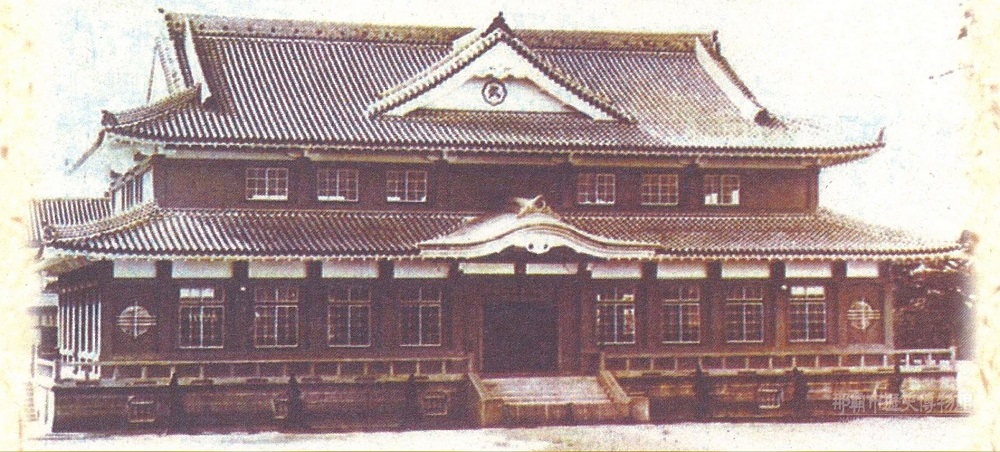The original Dai Nippon Butokukai (DNBK) was established in April 1895 in Kyōto to encourage the practice of the budō and to cultivate warlike virtues (butoku) throughout Imperial Japan. Branches were opened in each prefecture, aiming at the dissemination and promotion of budō using the existing organizational structure of the police forces.
The Okinawa branch of the DNBK was established in December 1933, when Karate’s exponents finally succeeded in formulating theories of indigenous development which were suitable for it to constitute a Japanese budō. With this opportunity, the wish for the construction of an exclusive martial arts performance hall (Butokuden) gained momentum. Centered on the Okinawa DNBK branch executives, the prefectural police department, as well as other parties concerned with the budō, donations were collected to raise funds for its construction.
As the premise for the construction was chosen the police practice place of the Okinawa Prefectural Government. Designed by Ōshiro Ryūtarō (1905-1992), the assistant engineer of the police department, construction works began in June 1938 and and were completed the following year.
The premise was of approximately 1089 square meters, with a gabled, hipped roof (shinmyō-irimoya), a reinforced concrete underground floor, and two floors above ground.
After completion, on Saturday, 17 June 1939, former Prime Minister of Japan, chairman of the DNBK, and General of the Imperial Japanese Army Hayashi Senjūrō (1876-1943), together with invited persons attended the grand opening ceremony of the DNBK Okinawa Branch Butokuden. For two days on the 17th and 18th traditional kata of karate and kobujutsu as well as jūdō and kendō were performed and a memorial tournament held.
At that time, Nagamine Shōshin performed “Chatan Yara no Kūsankū.” This is the earliest instance the name appeared like this in writing.

Nagamine Shoshin performed Chatan Yara no Kusanku in 1939 at the large opening ceremony of the Butokuden in Naha.
The Butokuden, as a place used for competitions, instruction, and dissemination of the budō, became a Mecca of the martial and military arts in Okinawa.

The Budokuden in the prewar-era. Note the character “bu” in the middle of the roof. Photo: Ōshiro Ryūtarō: Okinawa no Hukkō Tanpen, 1989.
Under wartime organisation it was converted into a munitions depot. The building survived the air raid of October 10, 1944 as well as the subsequent ground war with only little damage. Therefore it was praised by the US military as a “Indestructible Japanese-style building”.
The Butokuden was requisitioned by the US military and in April 1947 renovated as an officers‘ club, where dance events and the like were held. In 1949 it was handed over to the Okinawa Civil Government and was used as a government building. Since 1959 was used as a police facility for the practice of budō.
1985, with the plans to newly construct the Okinawa Prefectural Government building, the plans to tear down the Butokuden were announced. Although this triggered a movement to conserve the building, it was torn down in September of 1989. The site became part of the premises of the Okinawa Prefectural Assembly building.
The memorial of the former Butokuden is located in Naha Izumizaki 1-2-3. It is approximately a 2-minute walk south from the bus stop at the prefectural government north entrance. You find it located within the flower beds at the Okinawa Prefectural Assembly Office building.
© 2015 – 2022, Andreas Quast. All rights reserved.
